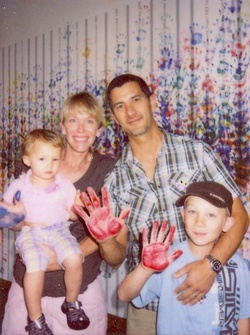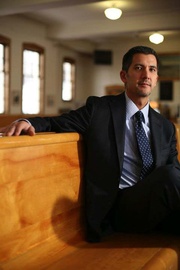“Although from far away, I have always felt close to the museum,” says Dr. G.W. (Greg) Kimura, the Japanese American National Museum’s new President and Chief Executive Officer.

Dr. Kimura with his family visiting the Museum's "Mixed: Portraits of Multicultural Kids" by Kip Fulbeck in 2010.
“I have been a member and supporter for years. My family makes a point of coming here whenever we are in the area, which has been at least once a year. A visit to the Museum is special. It is like a pilgrimage. I feel restored seeing the story of the community told in such a beautiful place. I have always been touched, really emotionally moved when here. It has been an experience I now relish for my kids, too.”
Kimura is philosophical about the notion that he represents a new generation that is taking charge of the Museum. “The thing about generational change is that there is always generational change,” he says. “I’m 43. If folks want to think of me as young, I am more than happy to indulge that! But seriously, I don’t think in terms of the passing of a torch as much as standing at a point in a long continuum from the past to the future.”
“So it means honoring those who came before and stewarding the Japanese American story for those who come,” Kimura adds. “Right now, the community and Museum are grappling with changes in demographics—from multigenerational Hapas to Shin-Issei. We are a large tent with a lot of diversity in it because there is no single ‘Japanese American experience’ but many experiences.”
“With all museums and nonprofits, the past few years have been difficult,” says Kimura. “Members, donors, and staff are stretched thin. But this is also the silver lining. People have passion for this place. They will do anything to see it continue to succeed and thrive. That energy pervades everything the Museum does. We are a center of the community’s history and identity and we are a focus point for its creativity and envisioning for the future.”
“Change is the only constant in life,” Kimura says. “So what is happening in the museum industry and in the Japanese American community is not something to react to but to embrace. Our community’s history is one of overcoming prejudice and discrimination. It is a story of tragedy, but it is also a story of hope and transcendence. In that sense, the story is bigger than the Museum and the community, and this is what I think is most important about what the Museum does. It is to help the U.S. live up to its promise. To help America become the best America it can be. We do this by telling the Japanese American story in all its complexity—warts and all—but also its glories, too. In doing so, we serve a nation of increasing diversity and a world of increasing interdependence. We build understanding, respect, and appreciation for the commonalities and differences among all people.”
Prior to taking the helm of the Museum in February, Kimura was President and Chief Executive Officer of the Alaska Humanities Forum, which is part of the National Endowment for the Humanities. He brings a diverse personal and professional background to his new role.
“I am a Yonsei (fourth-generation Japanese American), a fourth-generation Alaskan, and a Hapa,” says Kimura. “I am also a polymath, which is a fancy way of saying a jack-of-all-trades. I was ordained in the Episcopal Church at the ripe age of 24 and have served as a parish priest, university chaplain, and university professor and department chair.”
“The church background has taught me to be a good listener and an even-handed leader in the best and worst of times,” says Kimura, who holds a Ph.D. in philosophy of religion. “Remember, houses of worship were the first nonprofits. I’ve led a church through a fire and rebuild, held innumerable stewardship campaigns, counseled folks, and seen and heard just about everything. So I’m not easily fazed. I’ve also collaborated with other folks of faith, from Buddhist to Jewish and Moslem, which is another important aspect of diversity in the globalized world.”
“Six years ago I took over as the head of Alaska’s state humanities council,” says Kimura. “I found myself very quickly learning all I could about that state’s history and culture. The passion for culture, the arts and humanities, and people—especially their stories—has always been central to not only work and academics, but to how I live my life.”
That life, Kimura observes, was influenced the most by his Nisei grandfather, William Yusaburo Kimura, who was incarcerated at the Minidoka concentration camp during World War II.
“He was in art school in Seattle during the War before ending up in Minidoka, where he met my grandmother Minnie Mitamura,” says Kimura. “Grandfather was one of the first abstract artists in Alaska and the first art professor at the private university in Anchorage.”
“He never made any money at it and ran a laundry until the day he died,” Kimura recalls. “He had three loves that he loved with a boundless passion: his family, his art, and fishing. As a boy I remember him at the laundry all day, painting all night and still painting when we picked him up in the morning to go fishing. The only sleep he got was in the car on the way to and from the boat. I think of the boundless energy, the work, the suffering and sacrifice in camp. On coming back, he made a better future for his kids and grandkids.”
Kimura thinks often of his grandfather as he and his wife, Joy, raise their two children.
“I just wish to live up to his dreams, since everything that I have is due directly to him and, by extension, the sacrifice of all the Issei and Nisei.”
© 2012 Japanese American National Museum







